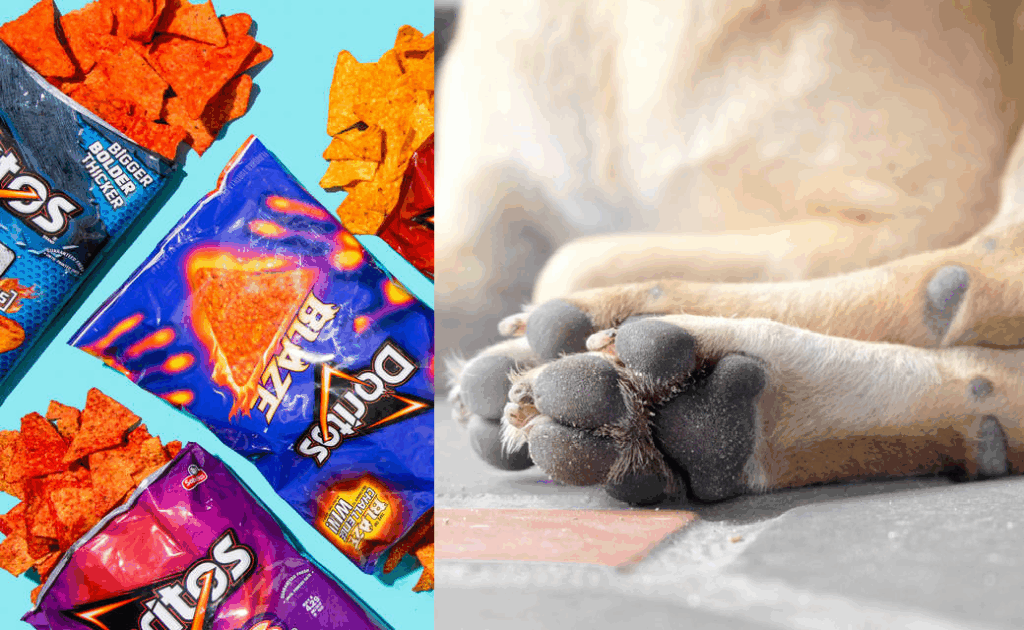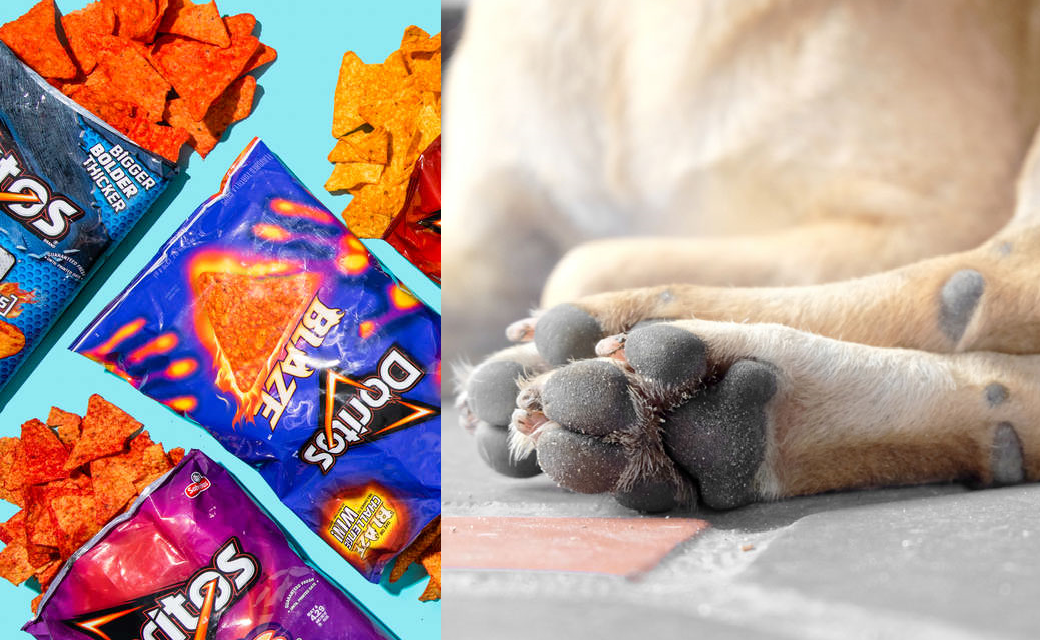
Why Does My Dog Smell Like Doritos? Unpacking the Frito Feet Phenomenon
Have you ever snuggled up to your canine companion and noticed a peculiar, familiar scent emanating from their paws? A scent that reminds you of your favorite cheesy, salty snack? If you’ve ever wondered, “Why does my dog smell like Doritos?” you’re not alone. This surprisingly common phenomenon, affectionately dubbed “Frito feet,” is something many dog owners experience. But what causes this cheesy, corn-chip-like odor, and is it something to be concerned about?
This article delves into the science behind Frito feet, exploring the microbial culprits, potential underlying health issues, and practical solutions to keep your dog’s paws smelling fresh. We’ll also examine when a Dorito-like scent might indicate a more serious problem requiring veterinary attention. So, let’s sniff out the truth behind this peculiar canine aroma.
The Microbial Culprits: Bacteria and Yeast
The primary reason your dog’s paws might smell like Doritos lies in the microbial ecosystem thriving between their toes. Dogs walk on various surfaces, constantly picking up bacteria and yeast from the environment. These microorganisms, perfectly normal inhabitants of your dog’s skin, flourish in the warm, moist environment of their paws.
Two common culprits are Pseudomonas and Proteus bacteria. These bacteria, along with certain types of yeast, produce volatile organic compounds (VOCs) as metabolic byproducts. These VOCs, released into the air, are what we perceive as that distinct Dorito or corn chip smell. Think of it as the natural fermentation process happening on a microscopic level. It’s similar to how certain cheeses develop their characteristic aromas.
While the presence of these microorganisms is normal, an overgrowth can exacerbate the smell. Factors contributing to overgrowth include:
- Moisture: Damp paws, whether from rain, puddles, or excessive sweating, create a breeding ground for bacteria and yeast.
- Poor Ventilation: Tightly packed toes, especially in breeds with thick fur, can trap moisture and limit airflow.
- Underlying Allergies: Allergies can cause inflammation and skin irritation, disrupting the natural skin barrier and making it more susceptible to microbial overgrowth. [See also: Dog Allergy Symptoms and Treatment]
- Weakened Immune System: A compromised immune system can make it harder for the body to control the population of bacteria and yeast on the skin.
Is Frito Feet Harmful to My Dog?
In most cases, Frito feet is a harmless condition. The presence of bacteria and yeast is a natural part of your dog’s skin flora. However, if the smell is particularly strong, accompanied by other symptoms, or if your dog is excessively licking or chewing at their paws, it could indicate a more serious underlying issue. These symptoms warrant a visit to your veterinarian.
Potential problems associated with excessive microbial growth include:
- Yeast Infections: Overgrowth of yeast, particularly Malassezia pachydermatis, can cause intense itching, redness, inflammation, and a characteristic musty odor.
- Bacterial Infections: Bacterial infections can lead to skin lesions, pus-filled sores, and pain.
- Pododermatitis: This is a general term for inflammation of the paws, which can be caused by various factors, including infections, allergies, and autoimmune diseases. [See also: Understanding Pododermatitis in Dogs]
How to Get Rid of Frito Feet: Prevention and Treatment
Fortunately, managing and preventing Frito feet is often straightforward. Here are some practical steps you can take:
- Regular Paw Cleaning: Wipe your dog’s paws daily, especially after walks, with a damp cloth or pet-specific wipes. Pay particular attention to cleaning between the toes.
- Thorough Drying: After cleaning or exposure to water, ensure your dog’s paws are completely dry. Use a soft towel to gently pat them dry, focusing on the areas between the toes.
- Paw Soaks: For more persistent odors or suspected infections, consider a paw soak with an antiseptic solution recommended by your veterinarian. Common options include diluted chlorhexidine or povidone-iodine solutions.
- Trimming Paw Hair: Regularly trim the hair between your dog’s toes to improve ventilation and reduce moisture buildup.
- Balanced Diet: A healthy diet supports a strong immune system, helping to control the growth of bacteria and yeast. Consider a diet rich in omega-3 fatty acids to promote healthy skin.
- Allergy Management: If your dog suffers from allergies, work with your veterinarian to manage their symptoms and prevent secondary skin infections. This may involve dietary changes, medication, or allergy shots.
- Proper Hygiene: Maintaining good overall hygiene, including regular bathing with a dog-specific shampoo, can help keep your dog’s skin healthy and balanced.
- Monitor Paw Health: Regularly inspect your dog’s paws for signs of redness, swelling, lesions, or excessive licking. Early detection of problems can prevent them from escalating.
When to See a Veterinarian
While Frito feet is often harmless, it’s crucial to know when to seek professional veterinary advice. Consult your veterinarian if you notice any of the following:
- Excessive Licking or Chewing: This indicates discomfort and could be a sign of infection or inflammation.
- Redness, Swelling, or Inflammation: These are signs of infection or irritation.
- Pus-Filled Sores or Lesions: These require immediate veterinary attention.
- Changes in Paw Pad Texture: Cracking, scaling, or thickening of the paw pads could indicate underlying skin conditions.
- Unpleasant Odor That Doesn’t Improve: If the Dorito smell is unusually strong and doesn’t improve with regular cleaning, it could be a sign of a more serious infection.
- Limping or Difficulty Walking: This could indicate pain or discomfort in the paws.
The Takeaway: Understanding and Managing Frito Feet
The mystery of why your dog smells like Doritos is now solved. The “Frito feet” phenomenon is a common occurrence caused by harmless bacteria and yeast thriving on your dog’s paws. While usually not a cause for concern, it’s essential to maintain good paw hygiene and monitor for any signs of infection or underlying health issues. Regular cleaning, thorough drying, and a balanced diet can help keep your dog’s paws smelling fresh and healthy. If you notice any concerning symptoms, don’t hesitate to consult your veterinarian. By understanding the science behind Frito feet, you can ensure your furry friend’s paws are happy and healthy, even if they occasionally smell like a bag of chips.
So, next time you catch a whiff of that familiar cheesy scent, remember it’s likely just a harmless case of Frito feet. A little extra care and attention to your dog’s paw hygiene can keep those paws smelling their best, and you can continue to enjoy those cuddles without the cheesy aroma.
Remember, if you’re still concerned about why does my dog smell like Doritos, always consult with a vet. They can provide personalized advice and treatment options for your canine companion.

